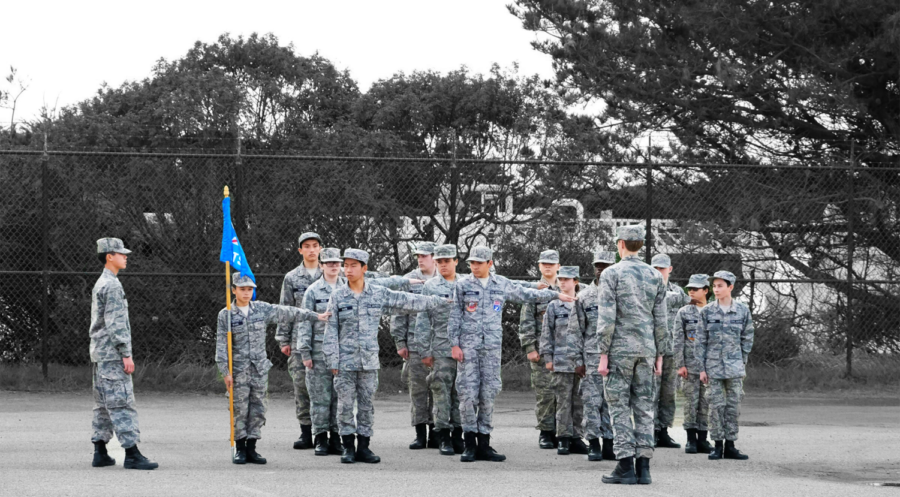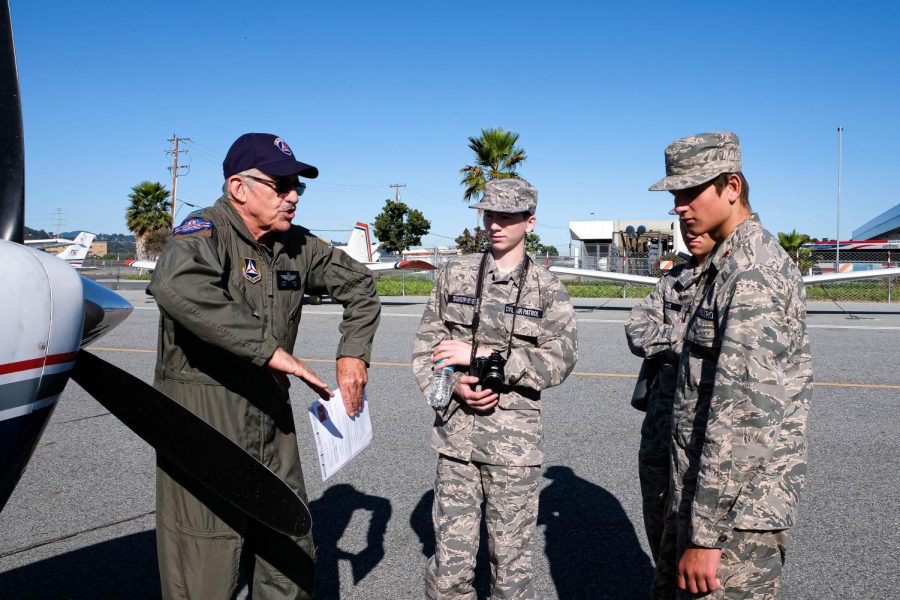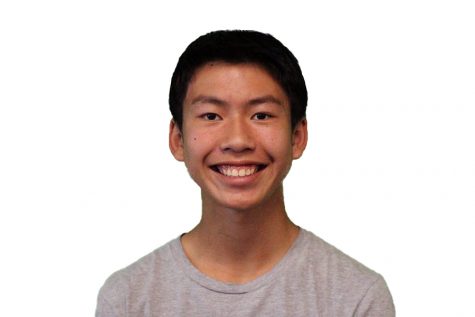“Semper Vigilans, Always Vigilant.”
This is the motto that defines Civil Air Patrol (CAP), the Air Force civilian auxiliary. Although it is similar to the well-known Scouts program, many are unaware of what CAP is and the impact the program has on its community and high school students.
CAP was founded during World War II, one of the deadliest conflicts in world history. The start of CAP would not only be impactful in the war but also in many events to come.
When the World Trade Center towers fell during 9/11, emergency services became critical. Aerial photography of the site was requested but the Air Force was incapable of capturing shots with their fighter jets. As a result, the White House and the Air Force tasked CAP to get the photos, thus establishing CAP as a national asset.
While it is not a guarantee that every member of CAP will be able to contribute to such an event, there are still missions being conducted around California and other states. About every other week, CAP is tasked by the Air Force Rescue Coordination Center or by another emergency service organization to execute a mission. Missions can range from search and rescue to disaster relief and aerial photography.
One such qualified member that participates in emergency service is Cadet Chief Master Sergeant Adithya Patil. As a junior in high school, he is qualified for many operations.
“I love … the number of opportunities that I get and how I’m making an impact on the world. [CAP is] tasked with life-saving missions, and even though I’m just 15 years old, I have so many valuable ways that I can help out, and I can see the effects that my work does,” Patil said.
Anybody in CAP can be a part of a life-saving mission if they are qualified, feel prepared, and have the time to help out. CAP is not an official job, so members take time out of their personal lives to help out in their community.
“I’ve been on one [mission] before … I was at school for robotics and I got a call saying that [CAP] needed my help … I went home and got my uniform … the experience was something new to me,” Patil said.
Emergency service is one of many ways for a high school student to help out in the community and possibly save a life. However, most high school students do not have the opportunity to do such a service because of when the missions occur. Rather, many will focus on CAP’s two other missions: aerospace and cadet programs.
Aerospace is one of three missions that CAP focuses on. In California, the aerospace program is very distinct; they host an annual aerospace camp called Aerospace Education STEM Academy. The academy is held at Edwards Air Force Base which allows for a unique experience of touring the base and hands-on time with STEM kits.
Cadet Chief Master Sergeant Thomas Durling, a junior, was inspired by the camp. In the future, he wants to fly for the Air Force.
“I got a close-up tour with a couple [of] F-35s which was really neat. From then on, I was fascinated with those jets and decided that I wanted to fly one of those,” Durling said.
While cadets can not fly the F-35s, they can fly a Cessna single-propeller plane. These opportunities are called orientation rides. Cadets are given a chance to fly the plane once the pilot, a senior member that has gone through many checkrides to ensure the safety of the cadets, has taken off.
According to the CAP website, their orientation ride motto is “safe, fun and educational.” The purpose of the orientation ride is to present cadets with the wonder of flight.
In addition to CAP’s missions regarding aerospace and emergency service, CAP’s other mission is the cadet program, the main focus of the civilian auxiliary. Anyone from ages 12 to 18 can be a cadet. As a matter of fact, several Carlmont students are a part of this program.
Cadet Staff Sergeant Benjamin Lee, a sophomore, has been in this program for over a year. For him, CAP has had more influence than he ever imagined.
“I initially thought it would be a bunch of kids crowding around and learning about a plane. What I got was completely different — amazing friends, my first real leadership position, making a resume and cover letter, learning to tie a tie, shine my shoes, and pushing my limits,” Lee said.
While cadets face challenges such as ensuring that their uniform is perfect, it can help many with facing their future challenges.
“Civil Air Patrol has helped me become a better person and developed discipline in me. I can always push through things that have been hard with my CAP experience. During the summer encampment, I endured and went through some of the toughest and hardest times away from home. Now, whenever I am going through something hard, I always relate back to these moments to tell myself, ‘I’ve done stuff harder than this, I can do this,’’’ Lee said.
With these skills and trials, CAP helps prepare cadets for their future. Cadet Airman Christian Rave, a senior at Carlmont, shares a similar sentiment. He has the goal of going to the Air Force Academy and CAP has helped him align to those goals.
“[CAP] has shown me that I have the capability to follow [leaders] and be in a military-style environment. It has also allowed me to explore aerospace concepts which I hope to explore further at the academy. Finally, it has given me a good basis with values like leadership and respect,” Rave said.
Although Rave is pursuing his goals to go to the Air Force Academy, cadets are not required to go into the military.
In fact, Cadet Lieutenant Colonel Tyler Beal, a junior in college, is pursuing a civilian job.
“I am a third-year student at UC Berkeley studying history, with my ultimate goal being in education. As a result of my experiences with Encampment, I feel ready to tackle the challenges presented before me in pursuing my goals,” Beal said.
Encampment is a modified Air Force basic training camp and in 2019, Beal was the cadet commander for the California Summer Encampment. Cadets come from all over the state to go through a week of intense training. Beal said that Encampment teaches cadets about followership, cadet and military life, and most importantly, teamwork. California’s Encampment program gives cadets skills to change themselves as a cadet and in their everyday lives.
As the Encampment cadet commander, Beal’s job was to lead almost 300 cadets and over 60 cadre, also known as staff members. His choice of taking on this significant responsibility was to give the cadets a life-changing experience like he experienced when he was a student at Encampment.
“I remember seeing Encampment as this daunting obstacle and unsure of whether or not I would be able to make it through to the end. However, I left Encampment with a newfound sense of confidence, and it ultimately set me down the path to where I am today. I can safely say that Encampment changed my life, and I wanted to provide that same opportunity for others,” Beal said.
While Encampment may be tough both physically and mentally, it is one of many ways Civil Air Patrol has positively affected students. This especially goes for the Encampment honor cadet, Cadet Staff Sergeant Bijan Zarrinkhameh, a sophomore.
“Encampment overall has taught me discipline, leadership, and responsibility. It also taught me how to work with a team. It has affected my future career by showing [me] that I [can] thrive,” Zarrinkhameh said.
All these achievements wouldn’t come without the support of senior members. Senior members are anyone over 18 years of age and they have greater responsibilities such as being a squadron commander.
First Lieutenant Stephen Collins is a squadron commander for the West Bay Composite Squadron 192. While his responsibilities are great in number, such as finance, administration, and public affairs, the position is fulfilling.
“Being a unit commander is very rewarding, in terms of the challenges one must overcome and the satisfaction when the outcomes are positive. I like to see my team succeed and see myself as [being helpful to] the squadron members,” Collins said.
These effective results come about through many skill sets of a commander. The former squadron commander for Squadron 192, First Lieutenant Cale Dunlap, describes his thoughts on the skill sets of a successful squadron commander.
“A squadron commander has to have effective leadership and communication skills in order to get their members to do things they may not necessarily want to do but for the good of the unit […] I like to think the really good commanders can read a member, figure out what they’re good at, and get them into the right role to be successful and fulfilled in the organization,” Dunlap said.
Cadet First Lieutenant Hannah Smith, a senior, can attest to this because at the age of 12, she started as a shy and unconfident leader. But, because of her experience and practice, she has become a better leader and public speaker.
Smith said, “As a [non-commissioned officer], you work with cadets on a personal level. You teach them how to move forward in their cadet career, and [you] get to say, ‘that’s my cadet’ when they accomplish their goals. As a cadet officer, you train the [non-commissioned officers] and you get to say ‘that’s my staff.’”



































1st Lt Timothy Vaughan, CAP • May 25, 2020 at 7:20 pm
Preston – You work here is top quality. I am the Public Affairs Officer for a Civil Air Patrol Composite Squadron in Eugene, Oregon. I will be using this fine report as a teaching tool for my cadet assistant PAOs.